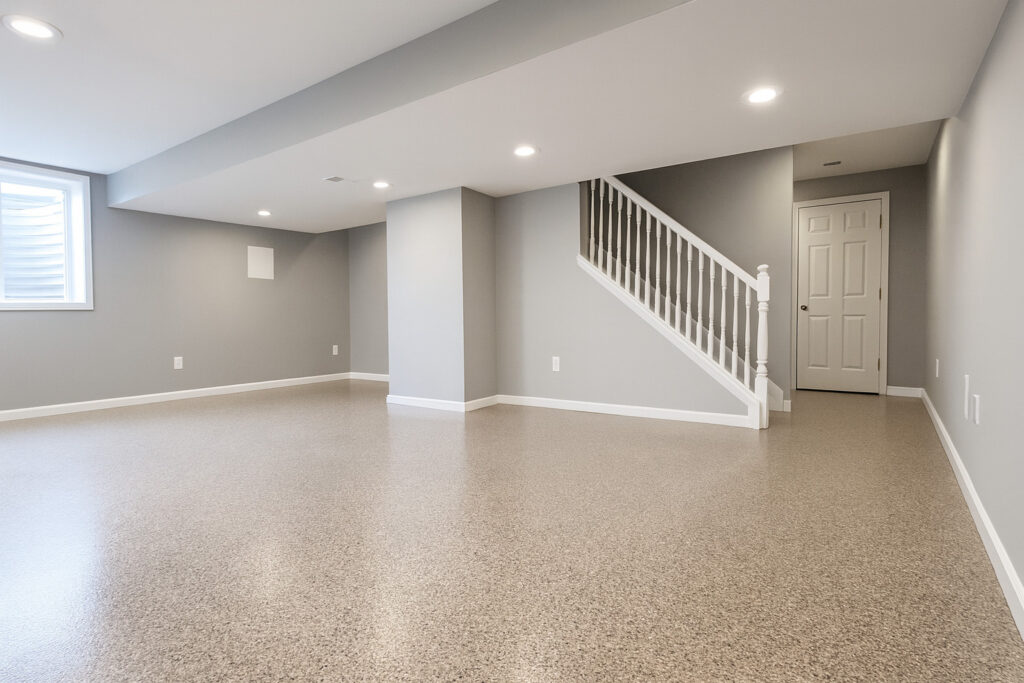If you’ve ever looked at your bare concrete floor and wished it had a more finished look, you’re not alone. Applying a DIY basement floor epoxy coating is one of the best ways to upgrade your concrete basement floors—adding durability, shine, and style while resisting stains and moisture. This guide walks you step-by-step through the entire epoxy project, from preparation to the final coat, so you can achieve professional-level results at home.
Why Epoxy Is the Best Choice for Basement Floors
Epoxy is more than just paint—it’s a two-part coating system that bonds tightly to your concrete surface to create a strong, seamless layer. The Part A (resin) and Part B (hardener) components chemically react to form a surface tougher than standard floor paints or driveway sealants.
When properly installed, epoxy flooring can last for many years—even in high-traffic areas like garages or basements. It resists water, oil, and chemicals while giving your space a clean, professional finish.
Whether you’re tackling a small diy project or coating your entire floor, this upgrade can dramatically improve your basement’s appearance and value.
Step 1: Assess and Prepare the Concrete Surface
Before you open the epoxy paint kits, it’s crucial to understand that surface preparation is the most important step in any epoxy coating job. A poorly prepared floor can lead to peeling or bubbling later. Before applying any coating, test your basement for trapped moisture to prevent adhesion problems. The U.S. Department of Energy’s Moisture Control Guide offers practical steps to identify and manage damp conditions.
1. Inspect for Damage
Check for hairline cracks, chips, or pitting. Use a putty knife and patching compound to fill small gaps.
If you notice moisture seeping through the floor, conduct a moisture test using plastic sheeting—tape a square to the concrete surface for 24 hours. If condensation forms underneath, your floor may not be ready for epoxy.
2. Clean the Floor Thoroughly
Start by sweeping away all dust and debris. Next, use a pressure washer with clean water and a degreaser to remove oil or other residues. Be sure to let the floor dry completely for at least 24–48 hours.
3. Etch the Surface
For the epoxy to adhere properly, the floor must be slightly rough or porous. Use an etching solution or muriatic acid mixed in small amounts with water (following the manufacturer’s instructions carefully). Always wear gloves and eye protection—acid wash produces hazardous solvent fumes.
Alternatively, many local home improvement stores like Home Depot sell pre-mixed etching solutions that are safer and easier to use.
Once etched, rinse thoroughly with clean water and allow the surface to dry again. You’ll know it’s ready when it feels like fine sandpaper under your hand.
Step 2: Gather the Right Materials and Tools
Having the right materials from the start helps ensure best results. You’ll need:
- DIY epoxy kit or basement epoxy kits (with Part A and Part B)
- Extension pole and roller covers
- Mixing bucket and stir stick
- Painter’s tape and drop cloths
- Putty knife for touch-ups
- Floor buffer or onfloor machine (for large spaces)
- Protective gear (gloves, goggles, and respirator)
- Decorative chips or color flakes (optional)
- Clear coat or top coat for extra shine
If you’re unsure about coverage, most kits list their square footage capacity—often around 250–500 sq ft per kit. Measure your entire floor and buy slightly more than you think you’ll need to stay on the safe side.
Step 3: Mix the Epoxy Correctly
Epoxy comes in two parts, and getting the ratio right is essential.
1. Combine Part A and Part B
Pour Part A (resin) into a clean bucket, followed by Part B (hardener). Mix them slowly using a drill with a mixing paddle for about three minutes. Be sure to follow the manufacturer’s instructions—especially the pot life, which tells you how long the mixture remains usable.
2. Add Color or Decorative Chips
Some epoxy paint kits allow you to tint the mixture for different colors or sprinkle decorative chips for texture and slip resistance.
If you want a solid color, skip the flakes; for a more finished look, scatter them lightly over wet epoxy as you roll it on.
Step 4: Apply the Epoxy Coating
Once mixed, epoxy starts curing quickly, so this part requires steady focus.
1. Start at the Back Wall
Using a brush, cut in along the edges and corners first. Then use your extension pole and roller to apply epoxy evenly across the floor in small sections. Work toward your exit to avoid stepping in wet epoxy.
2. Maintain a Wet Edge
Overlap slightly between passes for a smooth finish. Don’t stop in the middle of a section—the final result depends on keeping an even, continuous coat.
3. Apply Decorative Chips (Optional)
If you’re adding color flakes, toss them upward (like feeding chickens) while the epoxy is still wet. This method helps them land more evenly across the whole floor.
4. Let It Cure
Let the first coat dry per the manufacturer’s instructions—usually about 12 to 24 hours. Avoid walking on it during this period.
Step 5: Apply the Second Coat or Clear Coat
Most homeowners achieve the best results by applying a second coat or a clear coat for extra protection.
- For water-based epoxy, you may only need one coat.
- For solvent-based or industrial space applications, a top coat or matte finish can boost durability.
If your diy epoxy floor kit includes a clear coat, apply it after the first coat is fully cured. The clear coat enhances shine and protects against scratches and heavy objects.
Step 6: Finishing Touches and Cleanup
Once your final coat is dry, carefully remove painter’s tape from the edges. If any flakes or dust remain on the surface, sweep or vacuum gently.
Avoid placing throw rugs, furniture, or heavy objects for at least 48–72 hours to allow full curing. Keep away from open flames or heating sources during this time, since epoxy can release hazardous solvent fumes until cured.
Step 7: Maintenance Tips for Long-Lasting Floors
Your new epoxy basement floor should last years with proper care. Here’s how to keep it looking its best:
- Clean regularly with mild detergent and clean water.
- Avoid harsh chemicals or abrasives that could dull the epoxy finish.
- Use slip-resistant mats near stairs or doorways.
- Place pads under heavy objects to prevent scratches.
- Reapply a top coat every few years to refresh the shine.
A little maintenance goes a long way toward preserving your epoxy flooring investment.
Step 8: Comparing Flooring Options and Costs
If you’re still deciding whether to go with epoxy, here’s how it stacks up against other flooring options:
| Flooring Type | Durability | Moisture Resistance | Average Cost per sq. ft | Appearance |
|---|---|---|---|---|
| Standard Paint | Low | Low | $0.50–$1.00 | Flat, fades easily |
| Vinyl Tile | Moderate | Moderate | $2.00–$3.00 | Basic designs |
| Epoxy Coating | High | Excellent | $3.00–$5.00 | Glossy, customizable |
| Polished Concrete | Very High | Good | $4.00–$6.00 | Industrial look |
While epoxy may have a higher total cost upfront, it delivers unmatched longevity and visual appeal—making it the best choice for homeowners who want a great option that lasts.
Common Mistakes to Avoid
- Skipping surface preparation – The number one cause of failure is applying epoxy to dirty or damp concrete.
- Mixing incorrectly – Wrong ratios between Part A and Part B can cause soft or uneven curing.
- Waiting too long – Once mixed, you usually have less than 45 minutes before epoxy becomes too thick to apply.
- Not following manufacturer’s instructions – Every brand differs slightly; always read before starting.
- Applying in humidity – High moisture can lead to bubbling or peeling. Make sure your basement is dry and well-ventilated.
By following these basic steps, you’ll avoid common pitfalls and ensure a professional outcome.
How to Choose the Right Type of Epoxy
There are several types of epoxy coatings to choose from, each with pros and cons:
- Water-Based Epoxy: Easier for beginners, low odor, fast drying—perfect for most basements.
- Solvent-Based Epoxy: Creates a thicker layer and high gloss but requires good ventilation.
- 100% Solids Epoxy: Professional grade with the toughest finish, ideal for industrial spaces.
Many homeowners find that DIY epoxy kits with color options and pre-measured ratios offer the best balance between performance and ease.
Pro Tips for a Successful DIY Epoxy Project
- Temperature matters: Apply between 60°F and 85°F for optimal curing.
- Test small areas: Try a small section before coating the entire floor.
- Work in teams: One person rolls while another mixes—epoxy sets fast.
- Ventilate properly: Keep windows open and fans running to minimize fumes.
- Plan ahead: Once you start, you can’t stop midway.
By following these tips, your epoxy project will go smoothly from first step to final result.
The Hard Part: Patience
The hard part of any epoxy coating job isn’t rolling the paint—it’s waiting for the curing process. Rushing can ruin days of work. Be patient, and don’t walk on or wash the floor until fully hardened.
Remember: even if your floor feels dry after 24 hours, full chemical curing can take up to seven days.
Safety Considerations
Epoxy products can produce hazardous solvent fumes, especially if you’re using acid wash or solvent-based systems. Always wear a respirator, keep away from open flames, and store materials safely out of reach of children or pets.
If you’re unsure about working with muriatic acid, opt for a safer etching solution from your local home improvement store instead.
In Closing
A DIY epoxy floor project may seem intimidating, but with proper surface preparation, patience, and attention to detail, it’s a great way to give your basement a sleek, durable finish that rivals professional installations.
Whether you want a solid color shine, a decorative flake design, or a matte finish, your basement will instantly look cleaner and more modern.
So grab that diy epoxy kit, roll up your sleeves, and take the first step toward transforming your concrete basement floors. With the right materials and a bit of time, you’ll end up with a floor that’s not only beautiful but built to last.
Good luck—and enjoy your new epoxy finish!



